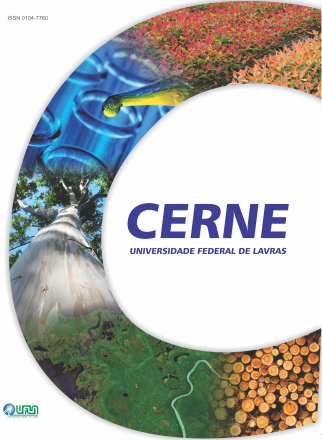DISPERSÃO ESPACIAL E ASSOCIAÇÃO INTERESPECÍFICA DE OITO ESPÉCIES DE PLANTAS MEDICINAIS DO CERRADO BRASILEIRO
Cerne
DISPERSÃO ESPACIAL E ASSOCIAÇÃO INTERESPECÍFICA DE OITO ESPÉCIES DE PLANTAS MEDICINAIS DO CERRADO BRASILEIRO
Autor Correspondente: Omar Daniel | [email protected]
Palavras-chave: plantas medicinais, fotossociologia, dispersão de plantas, agregação de espécies, cerrado
Resumos Cadastrados
Resumo Português:
O objetivo deste trabalho foi a aplicação de Ãndices de dispersão espacial e de associação interespecÃfica em oito espécies com
interesse medicinal do Cerrado brasileiro, sendo elas: Alibertia edulis, Anadenanthera falcata, Bauhinia holophylla, Bromelia balansae,
Cochlospermum regium, Dimorphandra mollis, Duguetia furfuraceae e Tabebuia aurea. Dados foram coletados em uma área de 32 ha, onde
foram alocadas sistematicamente 32 parcelas medindo 30 m x 10 m cada uma, distantes 100 m entre si. Em cada parcela foram registrados os
números de indivÃduos para as oito espécies. Na caracterização da dispersão e da associação interespecÃfica foram utilizados os seguintes
Ãndices:Morisita,McGuinnes,Fracker eBrischle,PayandeheoCoeficientedeHurlbert.Segundoos Ãndicesdedispersãoanalisados,amaioria
das espécies teve tendência ao agregamento ou agregadas e somente Dimorphandra mollis apresentou distribuição aleatória. O coeficiente de
associação interespecÃfica de Hurlbert indicou associação independente entre as espécies Duguetia furfuraceae e Tabebuia aurea com o restante
do grupo analisado. Merece destaque a associação negativa entre Anadenanthera falcata e outras duas espécies: Alibertia edulis e Dimorphandra
mollis. Estudos tem demonstrado que o gênero Anadenanthera apresenta efeitos alelopáticos sobre plantas-teste, o que ajuda a explicar esta
ocorrência. Em geral, as outras espécies estudadas apresentaram associação independente ou positiva.
Resumo Inglês:
This main purpose of this work was the application of spatial dispersion indexes and inter-specific association among
eight species with medicinal interest from the Brazilian Savanna, which are: Alibertia edulis, Anadenanthera falcata, Bauhinia
holophyla, Bromelia balansae, Cochlospermum regium, Dimorphandra mollis, Duguetia furfuracea, and Tabebuia aurea. Data were
collected in an area of 32 ha, where 32 plots of 30 x 10 meters, 100 meters far away from each other, were systematically allocated.
In each plot, the number of individuals belonging to each specie were registered. In the characterization of the dispersion and interspecific
association the following indexes were utilized: Morisita, McGuinnes, Fracker and Brishle, Payandeh, and the Hurlbert
coefficient. According to the dispersion indexes analyzed, the majority of the species showed a clustering trend or being aggregated,
and only Dimorphandra mollis presented random distribution. The Hurlbert s inter-specific association coefficient indicated
independent association among the species Duguetia furfuracea and Tabebuia aurea with the other analyzed species. It should be
emphasized that there was a negative association among Anadenanthera falcata and two other species: Alibertia edulis and Dimorphandra
mollis. Studies have demonstrated that the Anadenanthera genus presents alelopatic effects upon test-pants, which should help to
explain this occurrence. In general, the other species studied showed independent or positive association.

